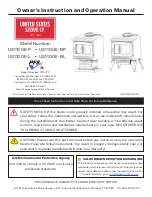
INSTRUCTIONS OF USE
19
3.
3.3.
Lighting
Use of the appliance in warm weather
(warm days, early hours of the afternoon
on sunny days) may lead to lighting and
updraught problems.
Certain weather conditions, such as fog,
ice, humidity entering the flue, etc., may
hinder sufficient updraught in the flue and
lead to suffocation.
Proceed as follows in order to light the
appliance satisfactorily:
•
Open the firebox door(s) and open
all the firebox air-intake inlets to the
full.
•
Place paper or a firelighter and
some wood chips in the firebox.
•
Light the paper or firelighter.
•
Leave the door slightly ajar, the
width of two or three fingers, for about
15 minutes until the glass warms up.
•
The first time the appliance is lit,
the fire should be gentle to allow the
parts of the appliance to dilate and dry.
Important:
The first time it is lit up, the
appliance may give off smoke and strange
smells. This is not a cause for concern.
Open an outdoor window to ventilate the
room during the first few hours of
operation.
If you notice water around the
appliance, this is produced by the
condensation of the moisture in the wood
on lighting the fire. This condensation will
no longer appear when the appliance has
been lit three or four times and has
adapted to its flue. If it does not disappear,
then check the flue draught (length and
diameter of the flue, flue insulation,
airtightness) and the humidity of the wood
used.
3.4.
Loading fuel
In order to load firewood, open the
firebox door gently, preventing the sudden
entry of air to the firebox so that smoke
does not enter the room that the appliance
is installed in.
Perform this operation with the glove to
prevent burns to the hands.
The maximum load height is 2 logs with
diameters of approx. 10 cm.
The minimum interval between loads
for nominal heat output is 60 minutes.
Always load with the nominal amount
(see table in section 1.1).
For minimum burning (e.g. at night), use
thicker logs.
When the firebox is loaded, close the
door.
3.5.
Operation
The appliance should be operated with
the door closed.
For safety reasons, never close all the
appliance’s combustion
-air intakes.
Primary-air intake
By opening this inlet, air enters the
firebox via the firebox grille.
Secondary-air intake
By opening this inlet, air enters the
firebox via the top of the firebox door.
IMPORTANT
: Keeping the secondary-air
intake open helps keep the door glass
cleaner for longer.
Содержание ITACA Series
Страница 1: ...Itaca 80 100 120 C V Instruction Book...
Страница 32: ...BASIC BREAKDOWNS 31 6...
Страница 33: ...BASIC BREAKDOWNS 32 6...
Страница 34: ...BASIC BREAKDOWNS 33 6...
Страница 35: ...DECLARATION OF PERFORMANCE 34 7 DECLARATION OF PERFORMANCE...
Страница 36: ...DECLARATION OF PERFORMANCE 35 7...
Страница 37: ...DECLARATION OF PERFORMANCE 36 7...
Страница 38: ...DECLARATION OF PERFORMANCE 37 7...
Страница 39: ...DECLARATION OF PERFORMANCE 38 7...
Страница 40: ...DECLARATION OF PERFORMANCE 39 7...
Страница 41: ...CE MARK 40 8 CE MARK...
Страница 42: ...CE MARK 41 8...
Страница 43: ...CE MARK 42 8...
















































